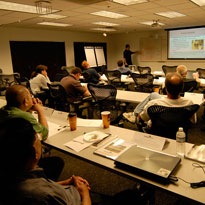LTE & IMS Interwork
- Course:LTE & IMS Interwork
- Course ID:LTE-IMS Duration:4 days Where: Your Office (7+ Persons)
- Download Course Description (PDF)
Available as a private, customized course for your group at your offices or ours and in some cases as a WebLive(TM) class.
Course Outline
Part 1: LTE
Session 1: Includes LTE essentials, fundamental elements, and LTE network architecture.
- LTE Roadmap and Standardization
- LTE Network Components
- UE
- eNB
- MME
- S-GW
- P-GW
- PCRF
- LTE Overview
- OFDM/OFDMA downlink
- SC-FDMA Essentials: Uplink
- LTE architecture: Interfaces
- LTE Layer 3 Signaling (RRC Layer)
- Network Entry and Attachment
- System Acquisition/Scanning
- Synchronization
- Default Bearer Establishment
- Idle Mode Operation
- Idle Mode
- Paging
- Tracking Area Update
Session 2: Includes LTE QoS, VoIP solutions, and solutions for VoIP session continuity
- QoS Management
- Different Classes of Services and Their Priorities
- Scheduling in LTE: Examples from Vendor Specific Architectures
- LTE Scheduler Optional Features (3GPP defined)
- Dedicated Bearers
- Handover in LTE
- X2-based Handoff
- S1-based Handoff
- Inter-RAT Handoff (LTE Inter-working)
- LTE-3GPP
- LTE-3GPP2
- LTE-Other Technologies
- LTE VoIP
- SRVCC for Voice Service Continuity over IMS
- One Voice or VoLTE for VoIP over LTE over IMS
Part 2: IMS
Session 1: IMS Network Design and Configuration
- Session Boarder Controller
- P-CSCF
- S-CSCF
- I-CSCF
- HSS
- ENUM and DNS
- CCF
- BGCF
- MGW
- Signaling and Bearer Paths Discussion
- Service Continuity Server
- VoIP Call Flow (access type independent)
Session 2: Core Network, Routing, Security, and Applications
- HSS
- IMS Parameters
- LTE Parameters
- Signaling vs. Bearer (paths and protocols over LTE through IMS)
- Routing, Difference of IPV4 vs. IPV6
- IMS Security
- Service Logic and Filter Control for Applications
- IMS Applications
- E911/IMS (cover overview of location services)
- TTY
- Messaging (text and multimedia)
- GETS (with LTE priority access)
- CALEA
- VoIP
- Video
Session 3: Interworking
- LTE/IMS Handoffs
- Call Flow: Establishing an Inbound Call over LTE into IMS
- Call Flow: Supporting a Call Terminating on IMS
- Call Terminating Back on LTE
- LTE/3G/IMS Handoffs
- Service Continuity Server
- Call Flow with Hand-off
- LTE/IMS Testing Requirements
- Wrap-up
- Course Recap and Q/A
- Evaluations
Course in a Nutshell
If your job requires understanding IMS and LTE and how they work together, this course can help you get there quickly. The first part of the course covers the basics of LTE, physical layer, control signaling, and RF management. You will learn the basics of LTE network elements and function, signaling, system acquisition, and basics of mobility management in LTE. The course then moves onto more advanced topics in LTE such as Quality of Service (QoS) management and scheduling, hand-over. inter-technology handover, power saving modes, VoIP, and session continuity via LTE. The second part of the course addresses intermediate to advanced IMS issues including: network design and configuration; core network, routing, security, and applications; and IMS interworking within an LTE environment.
Customize It!
The course can be extended to five days to include the prerequisite material on UMTS/HSPA and IP (if the audience is unfamiliar with it) or a deeper discussion of LTE and IMS. A shorter, 3 days version that covers the technologies in less detail is also available.
Learn How To
- Plan and engineer for LTE, IMS, and the two of them together
- Manage legacy services over IMS including 9-1-1 messaging and more
- Anticipate issues when rolling out new LTE and/or IMS based applications
Aimed At
This course is aimed at those who need to understand LTE and IMS and how they work together. This includes RF and network engineers, systems architects, product managers, OSS personnel involved with features and services, management, and support staff who can benefit from a better, juxtaposed understanding of LTE and IMS.
Prerequisites
General knowledge of telephony, wireless communications, and IP along, ideally, with some prior exposure to IMS and/or WCDMA through UMTS/HSPA.
- "Good coverage of all areas. Liked knowledge, depth, and enthusiasm of instructor. Great participant handbook! Good overall introduction to IMS/LTE with appropriate detail. Achieved better understanding of IMS/LTE interaction." – Manager, International Consulting Company
- “Very comprehensive look at LTE-IMS. Instructor had in-depth knowledge of internals, enthusiastic, interactive, approachable, easy going. Book very well laid out, good graphics.” – Participant, US Govt.

